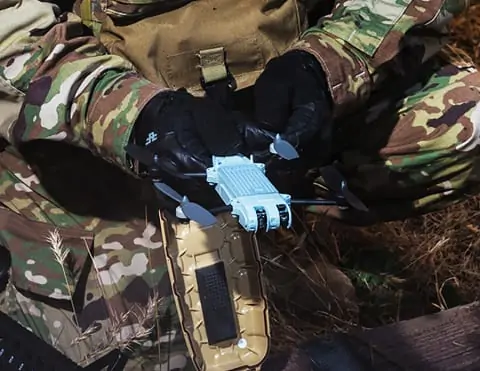
AeroVironment has unveiled the new Snipe Nano Quad, a miniature (“Class 0”) and field-rugged unmanned aircraft system (UAS) designed to support close-range intelligence, surveillance and reconnaissance missions.
“Snipe’s tiny size belies its impressive capabilities,” said Kirk Flittie, AeroVironment vice president and general manager of its Unmanned Aircraft Systems business segment. “It is quick, quiet, fast, durable and packed with advanced features critical to helping our customers succeed in close-range missions.”
“Snipe enables operators to spring into action quickly,” Flittie said. “No assembly is required for the five-ounce (140-gram) nano-UAS, which is designed to be worn by its operator so it can be deployed in less than a minute.”
Equipped with electro-optical/infrared (EO/IR), low-light-capable and long-wave infrared (LWIR) sensors in an integrated tilt mechanism, Snipe can relay high-resolution images and record real-time video both day and night. In addition, Snipe’s integrated UHF radio provides for excellent non-line-of-sight operation. The software-defined radio (SDR) allows Snipe to be sold commercially.
With its quiet electric motors, flight speeds exceeding 20 mph and more than one-kilometer range, Snipe is difficult to detect in operating environments with even minimal ambient noise. Its rechargeable batteries power approximately 15 minutes of flight time. Despite its small size, the durable nano-UAS is capable of operating under challenging environmental conditions – including winds of 15+ mph with gusts up to 20 mph.
“While Snipe’s stealthiness makes it ideally suited for military applications, it’s an invaluable asset for anyone needing a ‘Class 0’ UAS to support their missions,” Flittie said.
Snipe is controlled using an app on a standard, ruggedized (MIL-STD 810) touch screen controller. Other critical functions include Snipe’s ability to return to its operator automatically if it loses its radio link.
Snipe benefits from advances in nano unmanned technology achieved by the company in its development of the Nano Hummingbird. “The Nano Hummingbird, the world’s first unmanned aircraft capable of propulsion and control using two flapping wings, is an example of how our breakthrough innovation has spawned a valuable new capability in Snipe that now will help our customers proceed with certainty,” added Flittie.


















